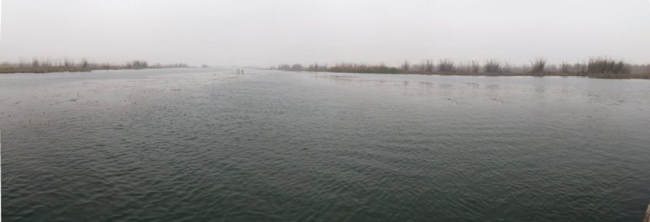Central Marshes
Central Marshes
- Country:
- Iraq
- Site number:
- 2241
- Area:
- 219,700.0 ha
- Designation date:
- 07-04-2014
- Coordinates:
- 31°10'34"N 46°59'E
Carousel
CarouselMaterials presented on this website, particularly maps and territorial information, are as-is and as-available based on available data and do not imply the expression of any opinion whatsoever on the part of the Secretariat of the Ramsar Convention concerning the legal status of any country, territory, city or area, or of its authorities, or concerning the delimitation of its frontiers or boundaries.
The Central Marshes are one of the three areas (along with Hammar Marsh, Ramsar Site no. 2242, and Hawizeh Marsh, Site no. 1718) that make up the once extensive and biodiverse Mesopotamian marshlands in southern Iraq. All three have now been designated as Ramsar Sites and so are under international conservation management.
The Site is a staging and wintering area for a number of globally threatened species such as the endangered Basra reed warbler (Acrocephalus griseldis) and the vulnerable greater spotted eagle (Aquila clanga) that migrate between their breeding grounds in western Siberia and their winter quarters in eastern and southern Africa. Other globally threatened species include the endangered Euphrates soft-shelled turtle (Rafetus euphraticus) and the vulnerable smooth-coated otter (Lutrogale perspicillata).
The Site provides a range of important regulating services such as flood control, water storage and purification, and climate regulation. The marshlands, before their drainage in the 1990s, were populated by Marsh Arabs who built floating islands and reed houses, developing entire villages linked by networks of main and minor channels. Thus, the marshes are also of extraordinary historical and cultural values. However, these services were either disrupted or degraded due to the extensive draining that took place in the 1990s due to war and land reclamation. In the 2000s, re-flooding and restoration projects brought back water and some of the biodiversity.
Administrative region:
Shared between three Governorates - Maysan, Thi-Qar and Basrah
National legal designation:
- National Park - Mesopotomia Marshland National Park
Last publication date:
24-09-2015
Ramsar Information Sheet (RIS)
- IQ2241RIS_1509_en.pdf
- IQ2241_map1411.pdf
Site map
Additional reports and documents
Other published literature

